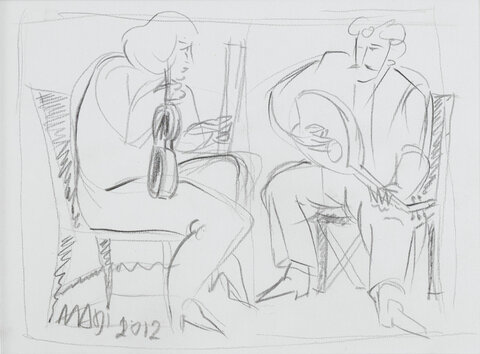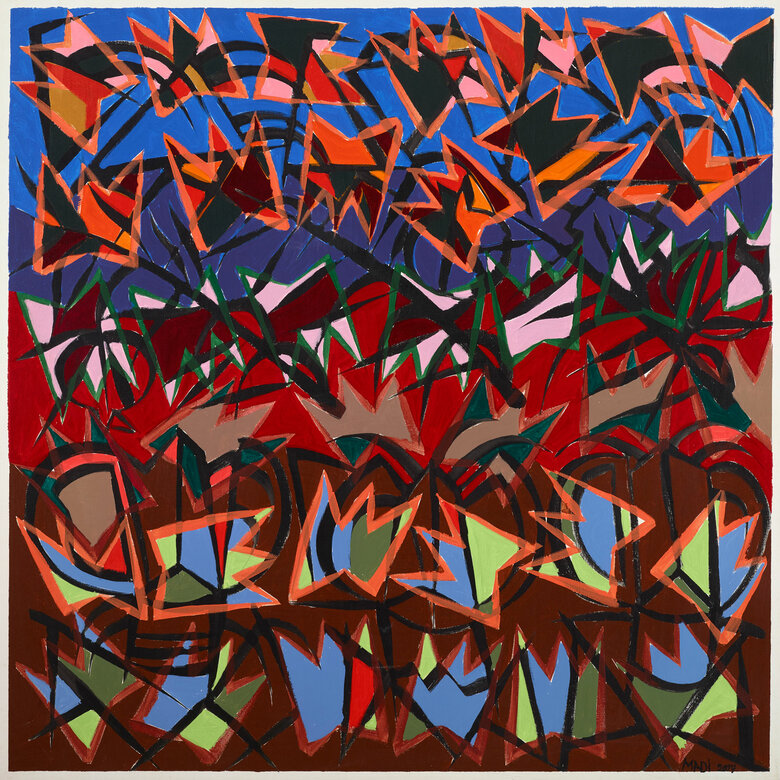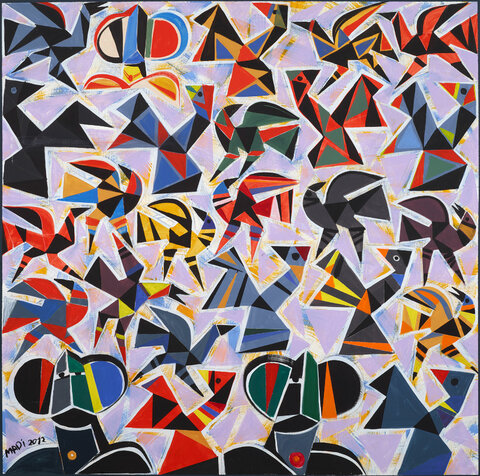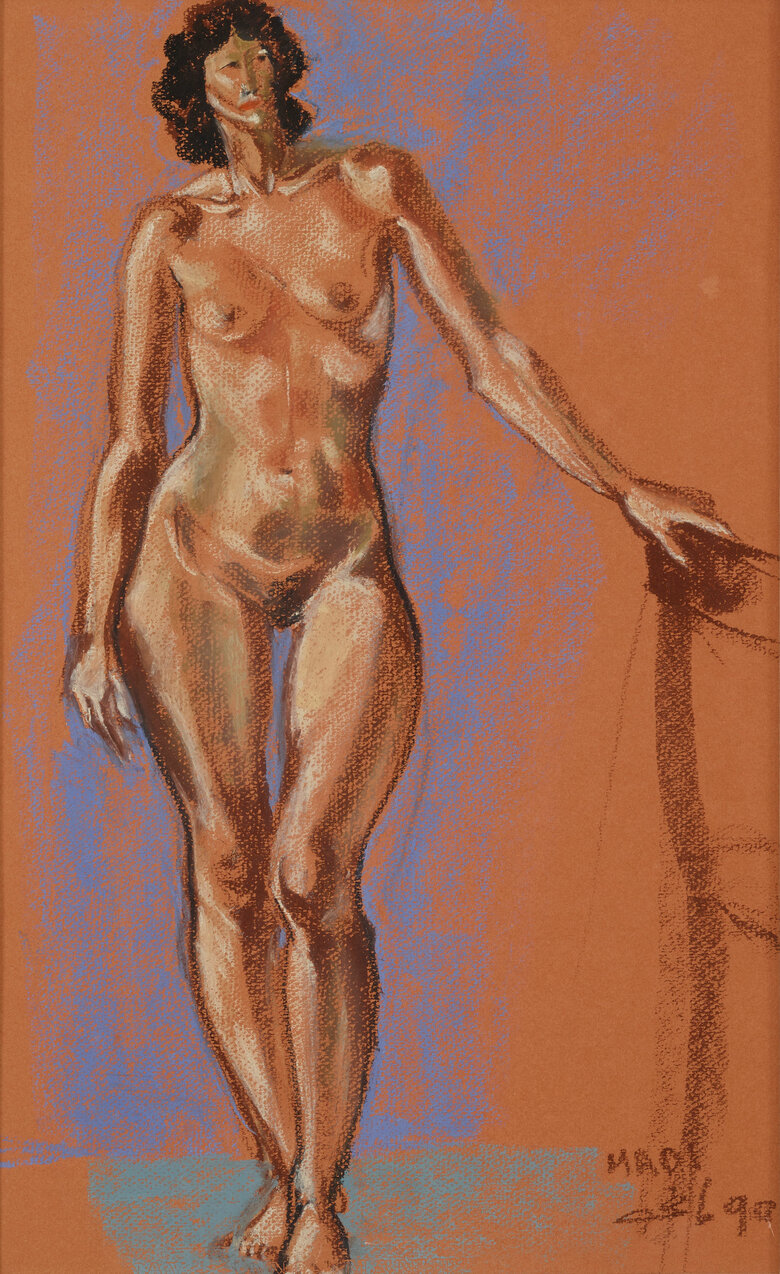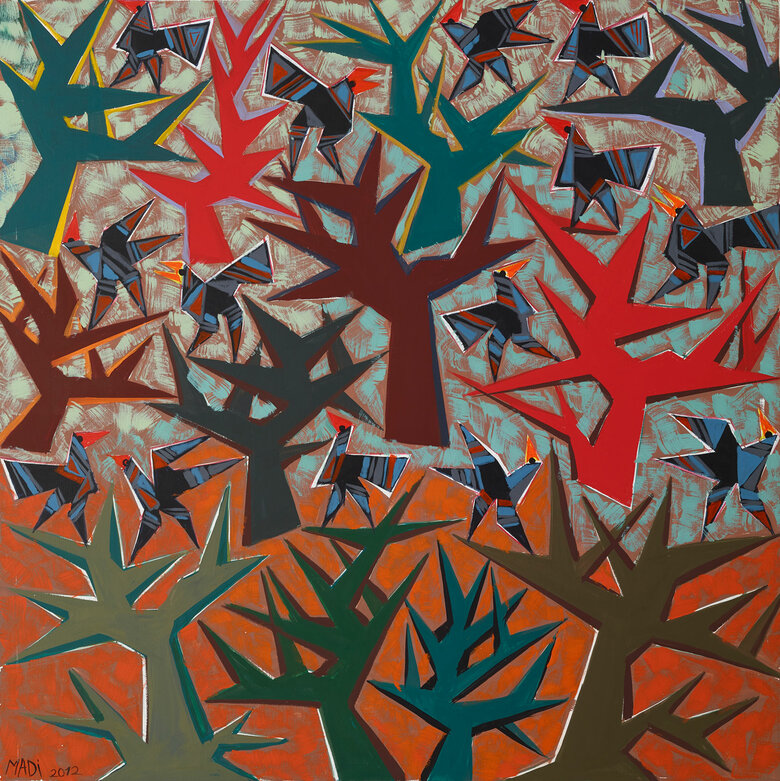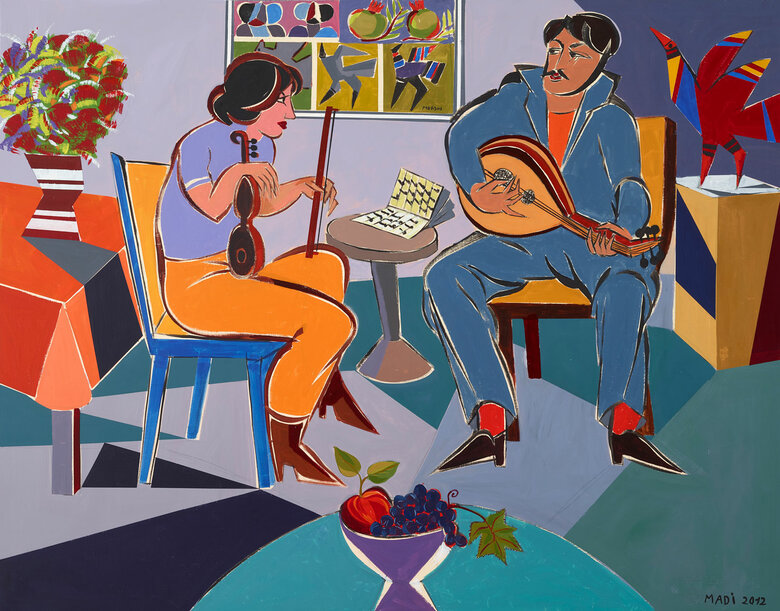Hussein Madi was born in Chebaa, a town on the southeastern tip of Lebanon, in 1938. He spent his summers following his paternal grandfather into the orchards, observing him perform with talent,...


HUSSEIN MADI, Lebanon (1938 - 2024)
Bio
Written by FADIA ANTAR
Hussein Madi was born in Chebaa, a town on the southeastern tip of Lebanon, in 1938. He spent his summers following his paternal grandfather into the orchards, observing him perform with talent, diligence, and mastery of his daily farming, carpentry, or blacksmith chores. From his stoic and wise grandfather, Madi learned methodology in work and persevering in any mission until its complete achievement.[1]
As early as in his elementary school years, Madi chose as a companion, the Larousse French dictionary, attracted by its one-line descriptive illustrations of birds, trees, and plants. The young boy would carry papers hidden between the Larousse pages and regularly try to draw the images of the book.[2] It was at the age of 18, in 1958, that Madi enrolled at the Lebanese Academy of Fine Arts (ALBA), against the will of his parents.[3] To sustain himself and pay his tuition, he had to work as an illustrator and caricaturist at several newspapers such as Dar el Kifah and Jaridat al Yaoum.[4]
Madi’s studies at ALBA were formative in the subject of human anatomy. The students worked with a live model called Mariam, and Madi was keen to observe, understand, and sketch every function of the human body and its relations with its environment.
When Mariam used to leave the atelier after her three-hours pose, Madi and his classmates would bring a porter from the street, and for a few piastres, they would dress him in a bathing suit and have him pose to be drawn.[5]
In 1963, after a failed attempt at obtaining a scholarship to study in Rome, Madi spent nine months, illustrating books and working for a daily newspaper in Baghdad, Iraq. He earned enough money to plan a two-month trip to Rome, but his two-month plan became an extended residence of 22 years. The artist enrolled at the Academia di Belle Arti di Roma in December 1963, where after a two-month trial period, he was accepted into the school and was even allowed to skip the first year.[6]
In 1965 the Lebanese Ministry of Education granted Madi a scholarship to further his studies in Rome. He won the sculpture award and was given 70.000 Lebanese Liras at that time. He also participated at the Salon D'Automne, organized by Sursock Museum, and was granted its first prize.[7] During his stay in Rome, Madi regularly visited Beirut; a couple of months each summer, to organize exhibitions in local galleries. During the summers, from 1972 to 1987 Madi taught at the Lebanese University’s Institute of Fine Arts. These two yearly months spent in Lebanon allowed the artist to earn some money and establish connections with the Arab art world [8]. Madi’s final return to Beirut was in 1986; he was by then, a multi-talented artist mastering a wide range of mediums and techniques in painting, sculpture, mosaics, fresco, and graphic art.
From Madi's perspective, the best source of artistic knowledge begins with a deep understanding of the elements he encounters, whether it is nature, a human body, or an animal. His acute detailing treatment of his surroundings allows him to observe every element, understand its composition, how it functions, and reproduce it in reduced lines and forms. The real inspiration behind Madi’s art is the nature itself and the creatures of God; his abstraction is a personal interpretation of the living[9]. In his particular way of scrutinizing the living object, Madi dissects its spiritual component and reduces its graphic representation to one unit. He depicts the birds, for example, in one singular design, in an attempt to capture the purest form of a bird, its meaning and essence. Madi creates a sort of a template that is endlessly repeated. Each of these units follows its particular set of rules: it varies in size, position, number, and color, but the core structure remains constant[10]. By superposing an abstract form that refers to a bird, in different colors, positions, and numbers, the artist explores the interactions of colors with each other. He inspects the relationships of those forms within the space of the painting.
The artist's abstract shapes gather in lines, whether horizontal, vertical, diagonal, or even undulant ones; they invite viewers to read and decode their interrelations, movements, and relationships between colors to reach their core. They form an alphabet pure of any semantic reference, that is not an Arabic one, nor a pictorial hieroglyph, it resembles more to the cuneiform scripts, it’s a journey towards the origins of the writing[11]. Shaped out of geometrical forms, lines, sharp angles, and curves, they hint towards the principles of Islamic art[12]. Their endless repetition retraces a Sufi dynamic, a passage to reach the creator; within this multiplicity, Madi performs the unity.
The repetition and interaction between shapes energize Madi's compositions. He structures his work within order and discipline as if he was building on an invisible grid. His templates or elements organize themselves in lines and sequences even when swarming on each other. Those overlapping shapes attract each other and repel from each other, creating an impression of movement in the painting. In the absence of shading, the templates shade one another; give a hint of depth for each other without suggesting any illusion of perspective. In Madi's figurative works, whether nudes or still lives, the volumetric figure monopolizes all the space of the painting, leaving behind it a background with a reduced suggestion of perspective.
Originating from his one line drawing, Madi’s metal sculptures are necessarily a 3D, real-life materialization of his designed shapes. By transposing his sketch on a metal sheet, he cuts it from the sheet, then bends and folds to show form, and create angles.[13] Madi transfers all his subject matters into sculptures; his women, horses, birds, bulls, apples, and flowers can be in a static posture, but mostly, they appear ready to take action.[14] The way he bends and folds his metal revives the form out of the flatness of the sheet, through shade and light, and prompts the allusion to origami (the Japanese art of folding paper to create designs out of a flat sheet of paper).
In Madi’s chromatic explorations, away from lights and shades, as in his flat shapes, one can see the reference to Picasso’s art; at the same time, the reference to Matisse is made clear in his simplified figures.[15] The diligence of Madi to read through the system of nature and analyze its rules capturing the essence of things is perceived as his anchor into Islamic art.[16] Throughout a prosperous production, Hussein Madi succeeded in portraying a signature stamp. The artist passed away in January 2024.
Notes:
[1] Aida Cherfan, “About Madi, the Man and the Artist,” in Madi: A Boundless Life (Beirut: A. Antoine, 2012), pp. 14-15)
[2] Helen Khal, “The Inner Structure of Madi's Art,” in The Art of Madi (London: Saqi Books, 2005), p.8)
[3] Helen Khal, “The Inner Structure of Madi's Art,” in The Art of Madi (London: Saqi Books, 2005), p. 9)
[4] Aida Cherfan, “About Madi, the Man and the Artist,” in Madi: A Boundless Life (Beirut: A. Antoine, 2012), p. 21)
[5] Helen Khal, “The Inner Structure of Madi's Art,” in The Art of Madi (London: Saqi Books, 2005), p. 9)
[6] Aida Cherfan, “About Madi, the Man and the Artist,” in Madi: A Boundless Life (Beirut: A. Antoine, 2012), p. 24)
[7] Aida Cherfan, “About Madi, the Man and the Artist,” in Madi: A Boundless Life (Beirut: A. Antoine, 2012), p. 27)
[8] Aida Cherfan, “About Madi, the Man and the Artist,” in Madi: A Boundless Life (Beirut: A. Antoine, 2012), pp. 32-34)
[9] Aida Cherfan, “An Encounter with Madi,” in Madi: A Boundless Life (Beirut: A. Antoine, 2012), pp. 132-133)
[10] Helen Khal, “Hussein Madi”, in Resonances, 82 Lebanese Artists Reviewed by Helen Khal (Beirut: Fine Arts Publishing, 2011), p.199)
[11] Abbas Baydun, Hussein Madi: lāʻib Al-aškāl (Beirut: Antoine Library, 2012), pp.9-10)
[12] Helen Khal, “Hussein Madi”, in Resonances, 82 Lebanese Artists Reviewed by Helen Khal (Beirut: Fine Arts Publishing, 2011), p.201)
[13] Abbas Baydun, Hussein Madi: lāʻib Al-aškāl (Beirut: Antoine Library, 2012), pp.39-43)
[14] Abbas Baydun, Hussein Madi: lāʻib Al-aškāl (Beirut: Antoine Library, 2012), p.47)
[15] Randa Sadaka, “5 De Pic - Hussein Madi,” Tele Liban Official, April 29, 2020, https://www.youtube.com/watch?v=tKNLe68P__0)
[16] Maha Azizeh Sultan, “حسين ماضي,” مجلة أجنحة الأرز - Art Focus, no. 172 (2019)
Sources
Khal, Helen, Joseph Tarrab, Michel Tapié, Martina Corgnati, Mounir Eido, and Samir Sayegh. The Art of Madi. London: Saqi Books, 2005.
Sultan, Maha Azizeh. “حسين ماضي.” مجلة أجنحة الأرز - Art Focus, no. 172 (2019).
Baydoun, Abbas. Hussein Madi: lāʻib Al-aškāl. Beirut: Antoine Library, 2012.
Baydoun, Abbas. Madi, Play & Recreation. Kuwait: Contemporary Art Platform, 2013.
Baydoun, Abbas, Aïda Cherfan, and Mounir Eido. Madi: A Boundless Life. Beirut: A. Antoine, 2012.
Tarrab, Joseph. Madi: Sculptures, 1969-2009: Bronze, Wax, Plaster, Terra Cotta, Wood, Cardboard, Galvanized Iron, Wrought Iron. Beirut: A. Antoine, 2009.
البيان. "الفنان حسين ماضي: الطبيعة معلمتي." البيان. October 10, 2016. Accessed January 30, 2018. http://www.albayan.ae/paths/books/2010-05-16-1.245154.
Madi Art - About US. Accessed January 30, 2018. http://www.madiart.me/AboutUs.html.
Khal, Helen, Cesar Namour, and Gabriel Schaub. Resonances, 82 Lebanese Artists Reviewed by Helen Khal. Beirut: Fine Arts Publishing, 2011.
Sadaka, Randa. “5 De Pic - Hussein Madi.” Tele Liban Official, April 29, 2020. https://www.youtube.com/watch?v=tKNLe68P__0.
CV
Selected Solo Exhibitions
2022
Hussein Madi: Les Femmes De Madi, Cromwell Place, London, United Kingdom
2019
Hussein Madi, Recent Works, Mark Hachem Gallery, Paris, France
Unexpected Trove - The Unseen Works of Hussein Madi (Rome 1964-1970), Beirut Art Fair, Beirut, Lebanon
2015
Hussein Madi in Amman, Jordan National Gallery of Fine Arts, Amman, Jordan
2014
An Endless Sense of Creativity, Collages, Lithographs, Paintings and Sculptures, Al Markhiya Gallery, Qatar
A Boundless Life, Beirut Exhibition Center, Beirut, Lebanon
2013
FA Central Bank, Beirut Digital District, Beirut, Lebanon
2011
An Art To See and Touch, Aida Cherfan Fine Art, Beirut, Lebanon
2010
Une Selections D’Oeuvres: 1960-2010, at Aida Cherfan Fine Art, Beirut, Lebanon
Marc Hachem, Paris, France
2009
Sculptures, Aida Cherfan, Beirut, Lebanon
2006
Paintings, Aida Cherfan, Beirut, Lebanon
2002
Drawings, Aida Cherfan, Beirut, Lebanon
2001
Sculptures, Aida Cherfan, Beirut, Lebanon
2000
Paintings and Sculpture, Aida Cherfan, Beirut, Lebanon
1996
Alice Moghabghab Gallery, Beirut, Lebanon
1988
Platform Gallery, Beirut, Lebanon
1985
Petra Bank Art Gallery, Amman, Jordan
1980
Italian Cultural Center, Beirut
1979
First Retrospective, Chamber of Commerce, Beirut, Lebanon
1978
Galerie Samia Tutunji, Beirut, Lebanon
1977
Galerie Samia Tutunji, Beirut, Lebanon
1976
Galleria Esagono, Lecce, Spain
1975
Novelli Gallery, Verona, Italy
1974
Samia Tutunji Gallery, Beirut, Lebanon
Galerie Modulart, Beirut, Lebanon
1973
Contact Art Gallery, Beirut, Lebanon
Trifalco Gallery, Rome, Italy
1972
Galleria d’Arte Cavour, Milan, Italy
1970
Soligo Gallery, Rome, Italy
1968
Dar El-Fann Gallery, Beirut, Lebanon
Poliedro Gallery, Rome, Italy
1965
Lebanese Association of Painters and Sculptors, Beirut, Lebanon
Selected Group Exhibitions
2020
Taking Shape: Abstraction from the Arab World, 1950s–1980s, Grey Art Gallery, New York, US
2019
A la Plume, au Pinceau, au Crayon: Dessins du monde Arabe, Institut du monde Arabe, Paris, France
2018
A Century in Flux, Sharjah Art Museum, Sharjah, UAE
2016
Beloved Bodies, Barjeel Art Foundation, Sharjah, UAE
The Short Century, Sharjah Museum, Sharjah, UAE
2015
Regards Sur Beyrouth: 160 Ans d’Images 1800-1960, Sursock Museum, Beirut, Lebanon
2013
Tajreed, Contemporary Art Platform, Kuwait
2012
Art From Lebanon, Beirut Exhibition Center, Beirut, Lebanon
2003
Venice Biennale, Italy
1998
Cairo Opera, Egypt
1997
Sharjah Museum, UAE
1996
23rd International Biennale, São Paulo, Brazil
1994
1st Cairo Int’l Biennale in Graphic Art Major, Cairo, Egypt
Darat El-Founoun, Amman, Jordan
1992
Sursock Museum, Beirut, Lebanon
1990
British Museum, London, UK
1989
L’Institut du Monde Arabe, Paris, France
1984
Kuwait Biennale, Kuwait
Print Biennale, Bradford, UK
1983
Lebanese Association of Painters and Sculptors, Beirut, Lebanon
1982
Sursock Museum, Beirut, Lebanon
1980
12th International Painting Festival, Cagnes-sur-Mer France
1978
International Print Exhibition, Lecce, Italy
1976
Islamic Art Exhibit, London, UK
1974
Cite de Lecce, Italy (1st prize in Sculpture)
Baghdad International Biennale, Iraq
1972
Ueno Museum, Tokyo, Japan
Galleria del Sole, Rome, Italy
Ministry of Tourism, Rome, Italy
Galleria Cortina, Milan, Italy
1971
Galleria La Satedra, Sulmona, Italy
1968
Salon d’Automne, Sursock Museum, Beirut, Lebanon
1967
Alexandria Biennale, Egypt
1966
Salon d’Automne, Sursock Museum, Beirut, Lebanon
1965
Alexandria Biennale, Egypt
Salon d’Automne, Sursock Museum, Beirut, Lebanon
Lebanese Association of Painters and Sculptors, Beirut, Lebanon
Awards and Honors
2003
Awarded the Ordine della Stella Della Soliderieta Italiana, with grade of Cavaliere, Italy
1974
First Prize for Engraving, Citta di Lecce, Italy
1968
Salon Prize for Sculpture, Italian Cultural Centre
1965
First Prize, Salon d’Automne, Nicolas Sursock Museum, Beirut, Lebanon
Collections
Ramzi and Saeda Dalloul Art Foundation, Beirut, Lebanon
MACAM, Aalita, Lebanon
Nicolas Sursock Museum, Beirut, Lebanon
The collection of the Ministry of Culture, Beirut, Lebanon
KA collection, Beirut, Lebanon
The collection of Ramzi Saidi, Beirut, Lebanon
The collection of Mazen Soueid, Beirut, Lebanon
Barjeel Art Foundation, Sharjah, UAE
Institut du Monde Arabe, Paris, France
The British Museum, London, UK
Chase Manhattan Bank, New York, US
Mathaf: Arab Museum of Modern Art, Doha, Qatar
The Khalid Shoman Collection, Darat Al Funun, Amman, Jordan
Jordan National Gallery of Fine Arts, Amman, Jordan
Press
Lebanese artist Hussein Madi dies aged 85
Maan Jalal
www.thenationalnews.com, English, 2024
Abstract and figurative painter leaves behind body of work showcasing his unique style
Hussein Madi, the Arab world’s Picasso, dies at 86
Zéna Zalzal
www.today.lorientlejour.com, English, 2024
The life and times of Hussein Madi
India Stoughton
www.thedailystar.com, English, 2017
Hussein Madi
Artspace Dubai
Wall Street International, English, 2015
15 Sep — 2 Nov 2015 at Artspace in Dubai, United Arab Emirates
الفنان حسین ماضي: الطبیعة معلمتي
Shaker Nouri
www.albayan.ae, Arabic, 2017
حسين ماضي: أطلقت الألوان بدلاً من الرصاص
غسان مفاضلة
www.alaraby.co.uk, Arabic, 2017
'Lebanese Picasso' Hussein Madi dies aged 86
www.artdayme.news, English, 2024
Hussein Madi, known as the Lebanese Picasso, died at the age of 86.rn
Hussein Madi_A boundless life_Beirut Exhibition Center_Press.pdf
معرض التشكيلي اللبناني حسين ماضي في «نبض».. اليوم.pdf
Hussein Madi, the _Picasso of the Orient_ Arts & Ent , Culture THE DAILY STAR.pdf
الفنان حسين ماضي «بيكاسو الشرق» » صحيفة فنون الخليج.pdf
جريدة الغد.pdf
HusseinMadi_Dar Al Funoon Gallery_Hussein Madi Exhibition_Press.pdf
HusseinMadi_Rétrospective de l’œuvre d’Hussein Madi_Agenda Culturel.pdf
حسين ماضي... «مايسترو» اللعب واللون!.pdf
HusseinMadi_Queen Rania inaugurates ‘Hussein Madi in Amman’ art exhibition_Jordan Times_Press.pdf
HusseinMadi_Hussein Madi Exhibition_Press.pdf
Hussein Madi_Alagalerie Aida Cherfan _Agenda Culturel_Press.pdf
HusseinMadi_‘Collages’, Hussein Madi_Agenda Culturel_Press.pdf
Hussein Madi_HusseinMadi_spaintings, sculptures and tactile pleasures_Free Online Library_Press.pdf
عباس بيضون يتوغل في عمق التجربة الطويلة لفنان كبير_ - جريدة مستقبل.pdf
سعورس _ الفنان حسين ماضي بقلم عباس بيضون.pdf
الفنان حسين ماضي_ الطبيعة معلمتي.pdf
حسين ماضي يرسم جماليات الجسد في بلا عنوان بدبي - جريدة الاتحاد.pdf
HusseinMadi_Girard Perregeaux & Hussein Madi_Bespoke Magazine_Press.pdf
HusseinMadi_Inside the Artist’s Exhibition_ Hussein Madi - Trendesign_Press.pdf
الاميرة عالية الطباع تفتتح معرض التشكيلي اللبناني حسين ماضي.pdf
يلاعب الأشكال والألوان ويصنعها _ الموقع الرسمي للجيش اللبناني.pdf
داخل معرض الفنان حسين ماضي - Trendesign.pdf
حسين ماضي لاعب الأشكال – مجلة نزوى.pdf
HUSSEIN MADI Artwork
Become a Member
Join us in our endless discovery of modern and contemporary Arab art
Become a Member
Get updates from DAF
Follow Artists
Save your favourite Artworks
Share your perspectives on Artworks
Be part of our community
It's Free!
We value your privacy
TermsCookiesPrivacy Policies
Become a Member
Get updates from DAF
Follow Artists
Save your favourite Artworks
Share your perspectives on Artworks
Be part of our community
It's Free!
We value your privacy
TermsCookiesPrivacy Policies
Become a Member
Get updates from DAF
Follow Artists
Save your favourite Artworks
Share your perspectives on Artworks
Be part of our community
It's Free!
We value your privacy
TermsCookiesPrivacy Policies
Welcome to the Dalloul Art Foundation
Thank you for joining our community
If you have entered your email to become a member of the Dalloul Art Foundation, please click the button below to confirm your email and agree to our Terms, Cookie & Privacy policies.
We value your privacy, see how
Become a Member
Get updates from DAF
Follow Artists
Save your favourite Artworks
Share your perspectives on Artworks
Be part of our community
It's Free!
We value your privacy
TermsCookiesPrivacy Policies


